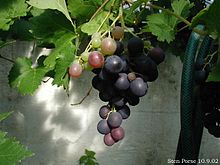Grapeseed oil
| Grapeseed oil | |
|---|---|
| Raw material plant (noun) |
Grapes ( Vitis vinifera ) |
| origin |
Seeds (kernels) |
| colour |
light yellow (hot pressed), light green (cold pressed) |
| ingredients | |
| Oleic acid | 14-24% |
| Linoleic acid | 63-75% |
| Linolenic acid | 0.2% |
| Palmitic acid | 5.5-11% |
| More fatty acids | 2-5% stearic acid |
| Σ saturated fat | 11% |
| Σ monounsaturated fatty acids | 19% |
| Σ polyunsaturated fatty acids | 70% |
| Vitamin A | to 4.49 mg / g |
| Vitamin E 2 | to 2.1 mg / g |
| Other ingredients | Lecithin , Procyanidin , Campesterol , Beta-Sitosterol , Stigmasterol |
| properties | |
| density | 0.92-0.936 kg / l at 15 ° C |
| viscosity | = 53-58 mPa · s at 20 ° C |
| Oxidation stability | 19.69 hours - 151 hours |
| Melting point | −16 ° C |
| Smoke point | 130 ° C (unrefined); 200 ° C (refined) |
| Iodine number | 121-160 |
| Saponification number | 176-206 |
| Calorific value | 39.4 MJ / kg |
| Manufacturing and Consumption | |
| Production worldwide | 60,000 tons (2013) |
| Most important production countries | Italy , France , USA |

Grapeseed oil is a vegetable oil that is obtained from the seeds (kernels) of grapes . It can be extracted from the kernels by hot or cold pressing , but it can also be extracted chemically . The pressing residue from cold pressing is processed into grape seed flour .
Refined grape seed oil can be heated to a very high temperature ( smoke point approx. 200 ° C) and can therefore also be used for frying. The triglyceride has a high proportion of alkenyl residues , which are derived from unsaturated fatty acids .
One liter of oil is obtained from approx. 40 kg of seeds, which roughly corresponds to the core content of 2 tons of grapes.
Hot pressed grapeseed oil
Hot-pressed grape seed oil is an edible oil with a neutral taste and color . However, due to chemical extraction, it contains smaller amounts of natural fat accompanying substances.
In the early 1980s, this oil hit the headlines because of the accumulation of samples containing high levels of polycyclic aromatic hydrocarbons . These probably came from smoke gases that were produced when the cores were dried.
Cold pressed grapeseed oil
In addition to the various fatty acids, cold-pressed oil also contains the antioxidants vitamin E , resveratrol , procyanidins (OPCs) and lecithin . It has a light green shimmering color and has a slightly nutty taste, although the grapes can still be tasted. It is therefore particularly suitable for cold use, for example for seasoning salads and sauces, with cheese or for pickling meat.
In addition, grape seed oil is used as the basis for cosmetic preparations ( VITIS VINIFERA SEED OIL according to INCI ).
Its use as a cosmetic is said to have been known since the Middle Ages . In modern times, oil has been extracted in this way again for a few years, starting in the USA and France . There are now oil mills in Germany that offer this product.
literature
- Sabine Krist: Lexicon of vegetable fats and oils . 2nd Edition. Springer, Vienna / Heidelberg / New York 2013, ISBN 978-3-7091-1004-1 , pp. 464-470 ( limited preview in Google Book search).
Individual evidence
- ↑ a b c d e f g Herman Lutterodt, Margaret Slavin, Monica Whent et al .: Fatty acid composition, oxidative stability, antioxidant and antiproliferative properties of selected cold-pressed grape seed oils and flours. In: Food Chemistry. Volume 128, Issue 2, 2011, pp. 391-399, doi : 10.1016 / j.foodchem.2011.03.040 .
- ^ A b c William M. Haynes: CRC Handbook of Chemistry and Physics. 95th Edition, CRC Press, 2014, ISBN 978-1-4822-0868-9 , Chapter 7.
- ↑ Sabine Krist
- ↑ BS Kamel, H. Dawson, Y. Kakuda: Characteristics and composition of melon and grape seed oils and cakes. In: Journal of the American Oil Chemists Society. 62 (5), 1985, pp. 881-883, doi : 10.1007 / BF02541750 .
- ↑ Herting DC, EJE Drury: Vitamin E Content of Vegetable Oils and Fats. In: J. Nutr. 81, 1963, pp. 4017-4021, PMID 14100992 .
- ↑ a b c d J. Schormüller: Alcoholic stimulants. Handbook of Food Chemistry, Volume VII, Springer, 1968, ISBN 978-3-642-46131-6 , p. 212.
- ↑ a b c E. Bames, A. Bömer et al.: Handbuch der Lebensmittelchemie. 4th volume: Fette and Oele , Springer, 1939, ISBN 978-3-642-88819-9 , p. 483.
- ↑ Alain Karle child: Manuel des corps gras. 2. Volumes, AFCEG, TEC DOC, Paris 1992, ISBN 978-2-85206-662-5 .
- ↑ List of smoke points on oil-kontor.de, accessed on May 1, 2017.
- ↑ Sergio Capareda: Introduction to Biomass Energy Conversions. CRC Press, 2014, ISBN 978-1-4665-1333-4 , p. 165.
- ↑ Matteo Bordiga: valorization of Wine Making By-Products. CRC Press, 2016, ISBN 978-1-4822-5534-8 , p. 280.
- ^ J. Derek Bewley, Michael Black, Peter Halmer: The Encyclopedia of Seeds: Science, Technology and Uses. CABI, 2006, ISBN 978-0-85199-723-0 .
- ↑ Angela Fässler: A small core with a big effect. (PDF), In: Health Consultation Hours. 01/01/2007, from mathier.com, accessed April 30, 2018.




